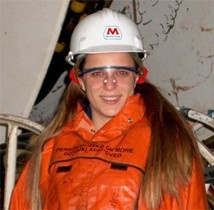Jane Hawken

B.Sc., Honours Earth Sciences, Â鶹´«Ã½ (2003)
M.Sc. Thesis
(PDF - 35.9 Mb)
Bottom Simulating Reflectors (BSRs) may represent free gas trapped below gas hydrates or a diagenetic transition such as that of opal-A to opal-CT in biosiliceous sediments. Determination of the origin of BSRs is important because they potentially result from vastly different geological processes. Gas hydrates represent a potential future hydrocarbon source and their dissociation, whether anthropogenic or natural, can result in sediment destabilization. Potential subsequent methane release may contribute to past and future climate change. This study investigates the origin of a segmented BSR imaged on industry-acquired 3D seismic reflection data offshore Newfoundland. The BSR cross-cuts Pliocene and younger contourite drift deposits of the Sackville Spur. The results show that depths to the prominent primary BSR and two deeper, poorly defined BSRs correlate to the theoretical base of hydrate stability depths for hydrates of variable thermogenic gas composition. Gas below the BSR is inferred based on a correlative low velocity zone on the F-09 well log. Effective medium models of these velocities predict minimal free gas concentrations of 0.5% and overlying gas hydrates concentrations of 2 to 10%. Free gas between and underlying the BSRs create amplitude, frequency and phase anomalies along the stratigraphic beds that intersect the BSRs. Based on these observations, the Sackville Spur BSRs are caused by hydrate accumulations. The top of an opal-A to opal-CT diagenetic front is interpreted to occur 365-660 m below the BSR. This diagenetic front is recognized as a high amplitude, faulted, late Miocene reflection that is generated by a dramatic increase in bulk density observed on well logs. Seismic stratigraphic analysis of the 3D volume shows post Miocene deposition was dominated by drift development on the flanks of Flemish Pass. The onset of sediment failures in the Pleistocene correlates to less drift development and increased deposition in the base of Flemish Pass. There is no direct spatial association between the BSRs and MTDs although the onset of pockmarks and failure scarps are stratigraphically equivalent, suggesting hydrate dissociation and sediment failure may have a common triggering mechanism. The Sackville Spur gas hydrate deposit represents a potential geohazard and must be considered during future development of the Mizzen hydrocarbon field.
Keywords: Sackville Spur, Hydrates, Bottom Simulating Reflectors, Late Miocene, silica diagenesis, opal Flemish Pass, North Atlantic Ocean, Geology--North Atlantic Ocean
Pages: 246
Supervisors: David Mosher, John Gosse



